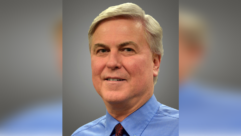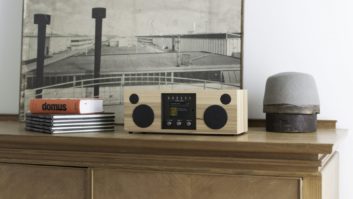(click thumbnail)Engineering is in his blood: Frank Foti and his 1/8th-scale live steam engine, running at the Lake Shore Live Steamers Club track in Kirtland, Ohio.Omnia Audio turns 10 this year.
The company is actually older. Audio processor manufacturer Cutting Edge Technologies began 19 years ago, founded by Frank Foti, who was then chief engineer of WHTZ(FM) in New York. In 1992 it merged with Telos Systems and was later renamed Omnia, the name of its DSP-based audio processors. That’s the anniversary the company observes this year.
Radio World spoke with founder and President Frank Foti.
What are you noting this spring?
Ten years ago was our first full-fledged effort into a digital audio processor — NAB1997, when Omnia was first introduced. Over the last 10 years, doing some back-of-hand calculating, it has been the hottest-selling audio processor, bar none.
Which models are you talking about and how do you know the competitive situation?
The more high-level, Omnia-6 and the Omnia-fm. As we look at our sales — and we know what other companies are capable of doing, because they’re public or what we hear from the dealer network — those products have outsold all others, in some cases 2-to-1 or 3-to-1.
Total, we’ve shipped between 7,500 and 10,000 units.
Why do you think you’ve succeeded in this market?
I’ll paraphrase Bill Clinton. I told myself, “It’s the sound, stupid.” The product, when properly used, sounds better than anything else on the dial.
How much more “blood” is left in the processing turnip? Quality wars might serve the broadcaster better than loudness wars as radio is forced to compete more with Web audio streams.
Great question. Would the next Omnia make you 3 dB louder? No. The challenge, the next frontier has to be in the area of quality.
Frank’s always continuing to develop and scheming and thinking. I came in once after not having listened to the radio in a while. I listened to it fresh, asked myself: “What do you not like?”
If we want to give conventional broadcasters another step forward, the goal would be to maintain the same competitive level — “loud,” yes; but what can we do to maintain the perceived level in the ear and maintain quality?
It comes down to audio processing magic that, once loaded into a targeted audio device, the audio level remains the same as what people are used to, but the audio quality goes up by one or two steps.
The tools are out there to make anyone’s ears bleed with any host of devices; but how good can it sound? We have to use our computer power, DSP and creativity to improve the product.
How low do you see bit rates falling for compression codecs in being able to sustain an acceptable “entertainment-quality” level over the next 5 or 10 years?
Coded audio is in our lives, whether we like it or not. I chuckle when I see people make claims like, “My facility has nothing to do with coded audio.” I beg to differ with them.
We deal with bit rates that are going lower and lower almost monthly. How low can it go? I wish I could give you an answer.
I remember in the early ’90s when Telos was showing what could be done in stereo at 128 kbps with what became known as Layer III. To think that same type of quality is now available in stereo at bit rates of about half that!
I’d be a fool to shut off whatever activity is out there in the minds of people who do codec work. The core of an HD stereo on AM is 32 kb and the audio quality is not that bad. That’s really saying something.
Are all circuits in the new Omnias modeled in software first and then evaluated in simulated or virtual hardware? Or is there still a place for “breadboarding” with actual hardware, as designs are perfected before becoming real?
If something runs on a computer and it works there and it’s software, then targeting it to DSP and a piece of firmware, all things will basically run the same.
In the early days of Omnia we had a circuit board with a couple of DSP cards from the [Telos] Zephyr. Now we’re able to model in simulation and in real time utilizing a computer, then basically take that model and turn it into executable code. The development process has changed quite a bit.
In the early days, when we did have a digital development board, I had a soldering iron on my workbench. I don’t even have a soldering iron anymore. We build a development platform and then develop the software.
Seventy-five to 80 percent of the work went into developing the platform, the hardware. Now 20–25 percent goes into that, the rest is all software.
We live in a world where much of the marketplace wants dedicated hardware/firmware, but others want it in the form of applications for Linux or Vista or other target platforms.
What should we expect at NAB?
We’ll show Omnia.8X, which is eight individual stereo audio processors running on a dedicated software-based engine. The application is multicasting or networks.
There are always developments in our core area of radio broadcasting, of coded audio. Our industry is pushing as strong as it can for HD Radio and multicasting to grow, and we’ve spent considerable time addressing that part of the marketplace.
As a “hobby,” if you will, we’ve been involved in supporting and promoting surround utilizing HD Radio. I see one more, if not two more, generations of audio processing with regard to conventional AM and FM radio, and out of that we’ll see more devices focused on over-the-air fidelity.
You’ve been vocal in the surround debate. What is your reaction to the recent report from the NRSC on broadcasting surround via HD Radio?
I think it was their way of showing the results of a year-and-a-half, two years of people getting on the phones every two weeks and debating the merits of their technology.
You don’t sound too impressed.
I’m really not. I think what it came down to was no one wanted to stand up and say, “You know what? If you’re gonna broadcast surround using HD Radio, you gotta do it carrying forward the best technology as possible.”
Stereo has always been carried forward. When stereophonic recording came into being, if the sound deserved to be in the left channel, it stayed in the left, or the right, or mono. That was acceptable to the consumer.
I find it difficult to believe that the whole listener experience doesn’t care, if different material is coming out of five different channels that that’s OK. I think that’s a response that is convenient.
They’re passing along remanufactured technology from the 1970s, the old Quad sound, and a lot of effort isn’t being given to honoring the original intent of the artists’ material.
Likewise, I have strong concerns that matrixed surround, when you try to pass it through the conventional FM stereo system, that the amount of degradation is considerably more than people on the NRSC are willing to admit.
Now some will say Frank Foti has a vested interest. Yes, we’ve known the people at Fraunhofer longer than anyone in the United States. But we wanted to do what was best for radio, that’s why we got behind the MPEG surround system.
[The report] was a way that a group of people could publish something. How much it’ll educate the market place I don’t know.
I contributed to it, actually. My contribution was cut and pasted from numerous papers I’ve done at NAB. I still carry a fairly strong opinion. I only hope broadcasters — if they choose to adopt the technology to get the “wow factor,” that they’re giving the best experience for their listeners.
Is surround happening at all?
The average person is saying no, it’s dead. But Donald Fagen got the Grammy for the best 5.1 CD audio disk for “Morph the Cat,” and the “Love” album, the surround form of it, has sold. Even some surround critics have said, “This may make me rethink the whole thing.”
There’s still too much confusion for the consumer. It’s not good enough yet to be more mainstream. But if we want to see radio have as strong a chance as any to be a viable medium, someone needs to get behind these ideas and give them the push they deserve.
Thoughts on Omnia turning 10?
The biggest is more personal and one of gratitude. In 1988 I had a crazy idea and in a fit of total insanity I went into business. I have many people to be grateful towards, one of which is my partner Steve Church. We put our heads together in 1992. Frank Foti is the guy who was hoping people would take a chance on his stuff; and he is very humble and grateful that they did.












